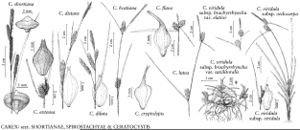Carex viridula var. viridula
Culms 2–40 cm. Leaves of flowering-stems slightly shorter than to exceeding culms, to 3.1 (–4.5) mm wide; ligules of distal cauline leaves usually obsolete. Inflorescences: peduncle of terminal staminate spike 0–20 mm; pistillate spikes 1–8, contiguous or proximal sometimes distant, sessile or short-pedunculate, globose to short-cylindric, 3–8 mm wide; terminal spikes staminate often with pistillate flowers interspersed, sessile or pedunculate, 8–20 × 1–3.3 mm. Perigynia yellow to grayish green, 1.8–3.9 × 0.8–1.6 mm, abruptly narrowed to straight or shallowly angled to 0–15 (–25) °, minutely scabrous or smooth beak; beak 0.3–1.3 mm. 2n = 70, 72.
Phenology: Fruiting Jun–Sep.
Habitat: Seasonally moist, open habitats, such as acidic, sandy or organic shorelines, calcareous runnels in limestone barrens, fens
Elevation: 0–3500 m
Distribution
Greenland, St. Pierre and Miquelon, Alta., B.C., Man., N.B., Nfld. and Labr., N.W.T., N.S., Ont., P.E.I., Que., Sask., Yukon, Alaska, Calif., Colo., Conn., Idaho, Ill., Ind., Maine, Mass., Mich., Minn., Mont., Nev., N.H., N.J., N.Mex., N.Y., N.Dak., Ohio, Oreg., Pa., R.I., Utah, Vt., Wash., Wis., Wyo., Europe, montane c Asia (Japan), montane c Asia (Sakhalin), montane c Asia (Kamchatka)
Discussion
Carex viridula subsp. viridula includes numerous variants, some of which have been treated as distinct species, such as C. serotina and C. scandinavica. The variation patterns are continuous across all of the segregates. Because of its ecologic amplitude, the taxon may occur with other members of the section, and in areas of sympatry hybrids often are formed. Hybrids between C. viridula and other species in the section are sterile hybrids among the subspecies of C. viridula are partially fertile (B. Schmid 1982).
Selected References
None.
Lower Taxa
"shortened" is not a number.
